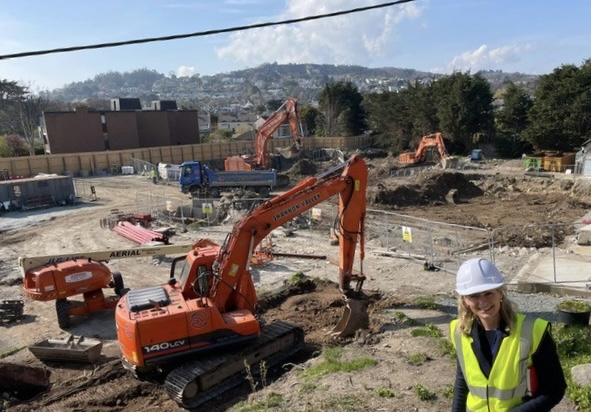Kate Rhatigan, design and policy director at Winterbrook, examines the shortage in zoned and serviced land restraining the industry and outlines the key policy priorities needed
Land is the foundation of housing delivery, yet Ireland lacks enough zoned and serviced land to meet demand. Despite ambitious targets under Housing for All, the land market remains stagnant, with little supply in the right locations and at the scale required to support development.
Land is an inelastic resource, particularly in Ireland, where geographical constraints and regulatory frameworks further limit available residential land. The lengthy planning and infrastructure processes – such as delays in securing planning permissions and connecting utilities – inflate costs and discourage development, exacerbating the housing affordability crisis.
A comparative perspective: Ireland vs. Denmark
At a macro level, Ireland simply has too little land designated for settlement. According to figures released by the Central Statistics Office in 2022, just 1.8 per cent of Ireland’s total land area is categorised as ‘settlement,’ compared to 7.59 per cent in Denmark – a country of similar population and smaller landmass.
This stark contrast highlights the restrictive nature of Ireland’s land-use planning policies. The National Economic and Social Council (NESC) has highlighted that while planning policies can prevent undesired development, they lack mechanisms to ensure that zoned and serviced land is utilized efficiently for housing (NESC, 2021).
This dysfunction in Ireland’s urban land system results in land often being unavailable in suitable locations at costs that allow for viable and affordable housing (NESC, 2021).
Housing demand: Conservative estimates will undermine supply
The draft National Planning Framework (NPF) has revised housing need projections from 33,000 to 50,000 new homes annually. However, this figure does not fully account for the 235,000-home supply deficit built up over the past decade, ongoing demographic shifts, and surging net immigration.
Over the next 15 years, at least 750,000 homes will be required. Adding the supply shortfall and adjusting for smaller household sizes, actual demand could be far higher.

Kate Rhatigan a director with Dun Laoghaire based property development company Winterbrook
Insufficient zoned land to meet targets
A September 2024 Goodbody report estimated that existing residentially zoned land could theoretically yield 417,000 homes – significantly below what is required to meet housing demand.
While this figure might suggest there is sufficient zoned land for residential development, a deeper analysis reveals critical limitations. Factors such as the poor location of much of this land and the low activation rates of planning permissions significantly diminish its practical potential.
When these constraints are considered, the real availability of viable residential land is far smaller than it appears on paper. Davy further identified land shortages for 40,000 – 70,000 units in the Eastern, Midlands, and Southern regions.
Despite this, county development plans have down-zoned housing supply targets by 8,095 units nationally – a contradiction to stated policy objectives.
The Economic and Social Research Institute (ESRI) has emphasised that land costs significantly impact housing construction viability, and the lack of detailed data on residential land prices hinders effective policy planning (ESRI, 2022).
Addressing this gap is critical to ensuring that land zoning and servicing align with actual housing demand.
Greenfield development: The pragmatic approach
If 50,000 homes per year are to be delivered in the short term, greenfield development must take the lead. These sites are faster and more cost effective to deliver than brownfield alternatives. The NPF targets 60 per cent of all new housing for greenfield locations, yet without a buffer of zoned and serviced land, these targets are unachievable.
Just as engineers apply a factor of safety, policymakers must over-zone to account for planning permissions that never materialise into built homes.
Strategic location: Aligning zoning with infrastructure
New land zoning must align with national utilities – water, power, waste, roads, and public transport. A laser-focused, transport-oriented development approach is essential to avoid urban sprawl and drive decarbonisation.
Without coordinated infrastructure investment, newly zoned lands will remain inactive. As NESC (2021) highlights, transport-oriented
development must be prioritised to create well-connected, sustainable communities.
The role of brownfield development
While brownfield development is critical for economic balance, these sites face viability challenges. High costs, complex planning, and long timelines make urban regeneration hard to deliver without state intervention.
Brownfield projects must be actively de-risked to drive delivery and meet embodied carbon reduction targets. NESC (2021) further notes that regeneration of these sites is essential for reducing whole-life carbon emissions but requires targeted government support.
A call for coordinated action
Policy must ensure an adequate supply of greenfield land to secure quick wins in housing supply. Continuous assessment of delivery outcomes is vital, and the newly established Strategic Housing and Infrastructure Delivery Office must lead with decisive action.
About the author
Kate Rhatigan is a qualified architect, with international experience working on projects ranging from housing to institutional schemes, notably the University of Greenwich School of Architecture and Construction at the University of Greenwich, London for Heneghan Peng. She is currently a director with Dun Laoghaire based property development company Winterbrook. Holding an MBA from Trinity College Dublin, she has previously worked as a solution engineer within the UK’s SMB sector.








